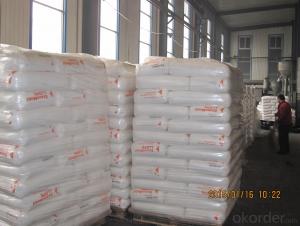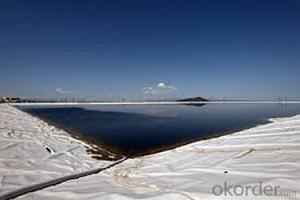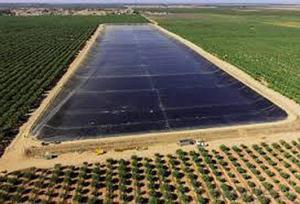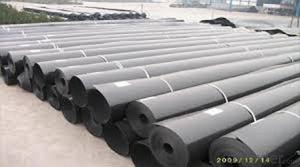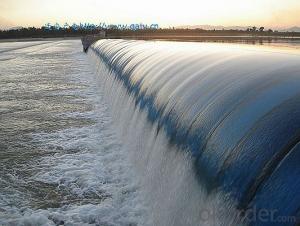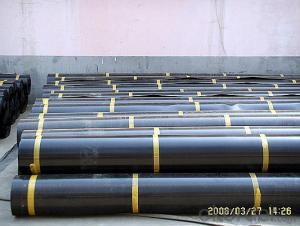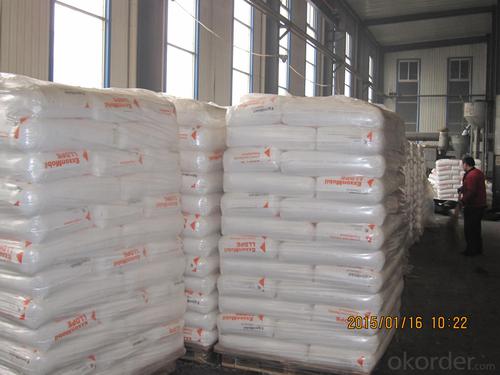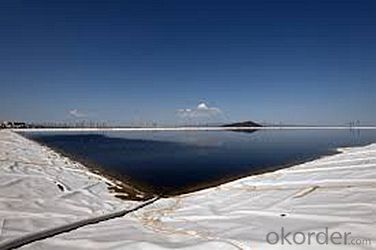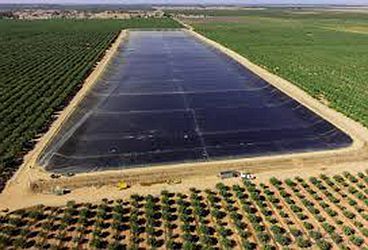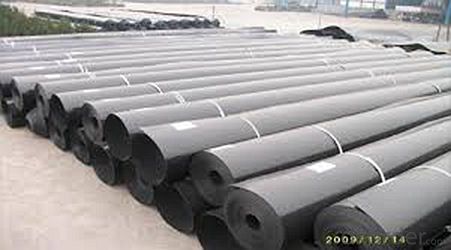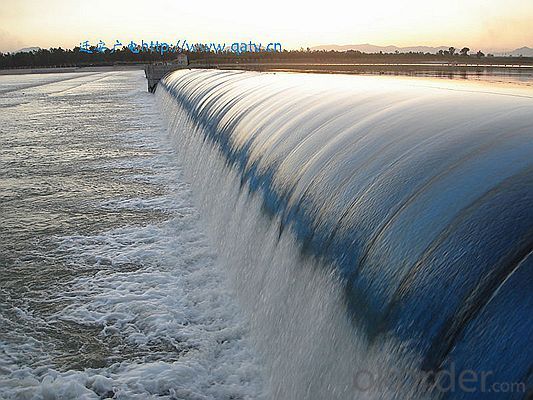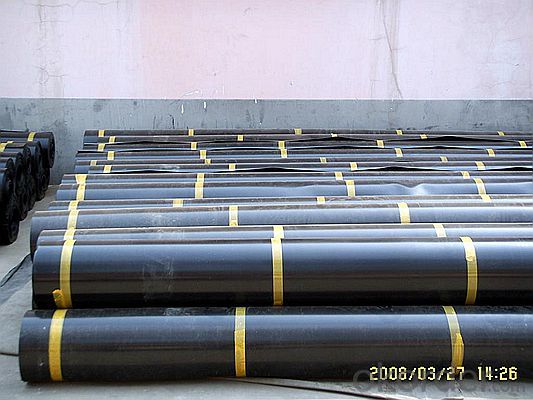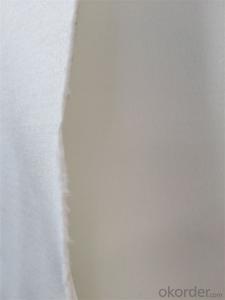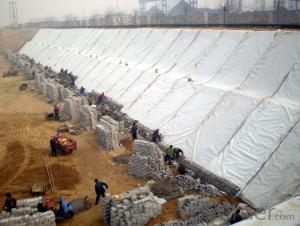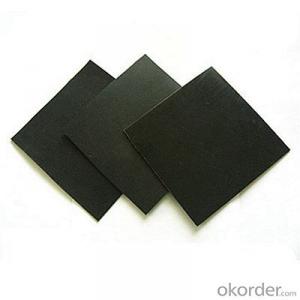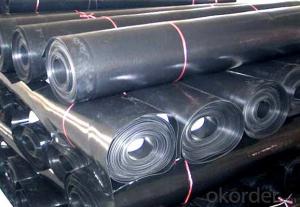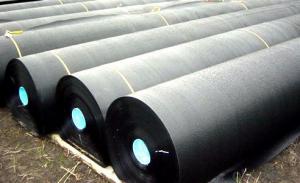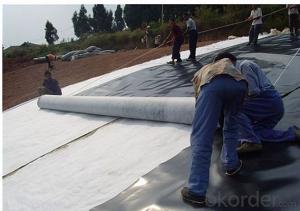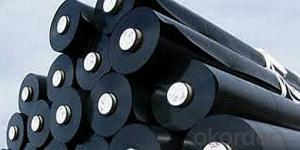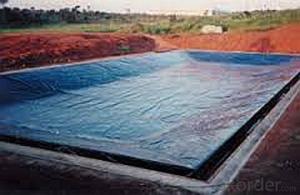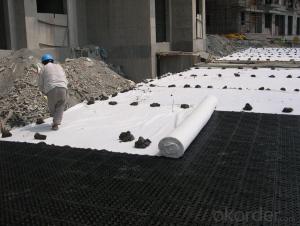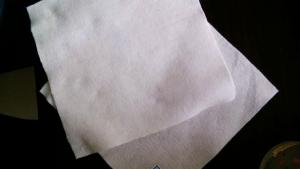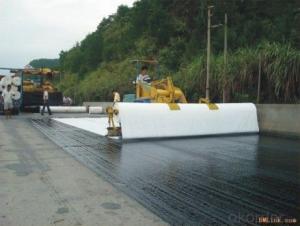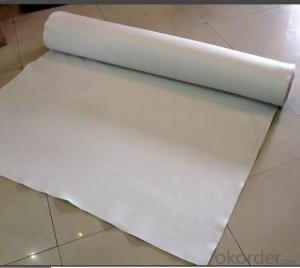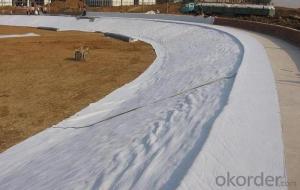Geotextil N2 Polyethylene Geomembrane for Waterproof Facing of Earth and Rockfill Dams
- Loading Port:
- China main port
- Payment Terms:
- TT OR LC
- Min Order Qty:
- 1000 m²
- Supply Capability:
- 1000000 m²/month
OKorder Service Pledge
OKorder Financial Service
You Might Also Like
Specification
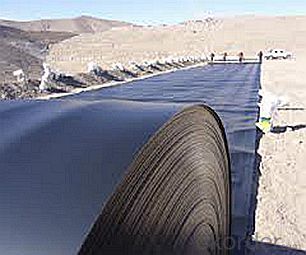
Property:
1.Good flexibility.
2.For service temperature range: -70°C--+110°C
3.Corrosion resistance, aging resistance.
4.Excellent environmental stress cracking resistance property.
5.High tensile strength and elongation.
Product Application Range
1) Domestic and Hazardous Waste landfills
2) Landfill closures
3) Heap leach mining and tailing dams
4) Biogas Management
5) Floating Covers
6) Waste water treatment reservoirs
7) Water conveyance channels and reservoirs
Technical specifications of HDPE geomembrane:
a) Density ≥ 0.94g/m2
b) Tensile Strength ≥25Mpa
c) Elongation at Break ≥ 550%
d) Right-angled Tear ≥ 110N/mm
e.)Puncture Strength ≥ 550N
Packaging & Shipping
Packing: PLASTIC FILM INSIDE, AND WOVEN BAG OUTSIDE
Shipping: About 15 days after receipt the deposit
geotextile fabric
permeability,filtration,easy for construction
ISO and CE certificate
Good quality and competitive price
Our Service
Quality assurance
1.On a regular basis or as per your request,we entrust national testing agencies to conduct quality inspections
2. Strictly in accordance with the ISO9001-2008 international quality system standard,we monitor and manage the whole process throughout production,quality testing,and measurement to ensure product quality
3. For quality-related construction delay or substandard construction(except for damage or losses due to customer’s responsibility or irresistible natural disasters),we have refunding,replacement,and repair services.We will respond to customers’ feedbacks on quality issues within 24 hours.
After-sales service
1.In order to provide customers with comprehensive technical support,we will provide technical and other related information upon request in a timely manner.
2.In required,we will appoint specialized technicians to the construction site to give technical trainings to construction people,and offer technical guidance throughout the whole construction process.
3.For damage due to shipment and delivery,after we receive the complaint,we will check the issure through provided pictures and videos.If our responsibility is confirmed,we wil offer free replacement.
4.When the construction is completed,as your request,our technical staff may participate in the final acceptance.
FAQ:
Q: What kind of payments does jenor support?
A: T/T, L/C, Cash are accepted.
Q: Do you charge for the samples?
A: Accordeing to our company policy, the samples are free, we only charge the freight fee. And we will return the freight fee during the next order.
Q: Can you produce according to customers' design?
A: Sure, we are professional manufacturer, OEM and ODM are both welcome.
Q: Do you have other products?
A: Yes, please check the pictures:
- Q: How do geotextiles contribute to the sustainability of construction projects?
- Geotextiles contribute to the sustainability of construction projects in several ways. Firstly, they can be used as a substitute for traditional materials, such as gravel or sand, which reduces the demand for natural resources and minimizes environmental impact. Secondly, geotextiles improve soil stability and prevent erosion, ensuring the longevity of structures and reducing the need for costly repairs or replacements. Additionally, these textiles can enhance the efficiency of drainage systems, leading to reduced water consumption and improved water quality. Overall, geotextiles promote sustainable construction practices by conserving resources, enhancing durability, and minimizing environmental degradation.
- Q: What are the applications of geotextiles in coastal engineering?
- Geotextiles have several applications in coastal engineering, including shoreline protection, erosion control, and sediment filtration. They are used to stabilize and reinforce coastal structures such as revetments, breakwaters, and seawalls. Geotextiles also help in preventing soil erosion by acting as a barrier between the beach or dune and the water, reducing the impact of wave action. Additionally, they can be used to filter sediment and prevent the clogging of drainage systems in coastal areas. Overall, geotextiles play a crucial role in maintaining and safeguarding coastal environments.
- Q: Can geotextiles be used for erosion control in golf courses?
- Yes, geotextiles can be used for erosion control in golf courses. Geotextiles are permeable fabrics that can be installed to stabilize soil and prevent erosion by providing a barrier against water flow. They are commonly used in various landscaping applications, including golf course construction and maintenance, to control erosion and improve soil stability.
- Q: Are geotextiles suitable for use in geogrid reinforced embankments?
- Yes, geotextiles are suitable for use in geogrid reinforced embankments. Geotextiles provide separation and filtration properties, which help to prevent soil erosion and ensure the stability of the embankment. They also enhance the overall performance of the geogrid by improving load distribution and reducing differential settlement. Therefore, using geotextiles in conjunction with geogrids is a common and effective method for reinforcing embankments.
- Q: What are the advantages of using geotextiles in wetland restoration projects?
- There are several advantages of using geotextiles in wetland restoration projects. Firstly, geotextiles provide effective erosion control by stabilizing the soil and preventing it from washing away during heavy rainfall or flooding. This helps in maintaining the wetland's structure and preventing further degradation. Secondly, geotextiles act as a barrier, preventing the migration of harmful substances such as pollutants or excess nutrients from adjacent areas into the wetland, thus protecting its ecological integrity. Additionally, geotextiles can enhance vegetation growth by retaining moisture in the soil, promoting root development, and preventing weed growth. This ultimately contributes to the overall success of wetland restoration efforts.
- Q: Geotextile longitudinal and lateral elongation gap is too much how to adjust
- 1. The elongation at break of the geotextile is divided into longitudinal elongation at break and transverse elongation at break. Generally speaking, the elongation at longitudinal and transverse faults is not very different. GB GB / T-2008 standard requirements geotextile longitudinal and lateral elongation between 20% -100% are qualified. 2. Longitudinal transverse fracture elongation gap is too large, you can check the mixing hopper, carding machine is mixed evenly, combing evenly. 3. Acupuncture machine too fast or too high acupuncture may lead to geotextile longitudinal and transverse elongation gap, you can try to debug the speed of the next needle machine. 4. Appropriate to add some industrial oil can enhance the geotextile rupture strength, and elongation at break.
- Q: Geotextile laying should be beyond the edge of how to set the number of specific requirements? Which specification is more detailed
- Geotextile laying should be beyond the edge of how to set the number of specific requirements? You want to understand this situation, there is no clear norms, but can refer to the "garbage sanitary landfill seepage control system engineering technical specifications" (CJJ133-2007) 5.6.6 of the provisions of not less than 300mm is possible The Article 5.6.6 of CJJ133-2007 states that: ... the repair range shall be greater than 300mm around the breakage range.
- Q: Geotextile puncture test standard
- Staple stitch filament piercing filament woven weaving
- Q: In the laying of composite geotextile water layer, what is wf115-0.2mm type
- Supply of composite geotextile, geomembrane.
- Q: Can geotextiles be used in erosion control on steep slopes?
- Yes, geotextiles can be used in erosion control on steep slopes. Geotextiles are permeable fabrics that can help stabilize soil and prevent erosion by providing a barrier against water flow while still allowing for drainage. They can be used to reinforce soil, control sediment movement, and retain vegetation on steep slopes.
Send your message to us
Geotextil N2 Polyethylene Geomembrane for Waterproof Facing of Earth and Rockfill Dams
- Loading Port:
- China main port
- Payment Terms:
- TT OR LC
- Min Order Qty:
- 1000 m²
- Supply Capability:
- 1000000 m²/month
OKorder Service Pledge
OKorder Financial Service
Similar products
Hot products
Hot Searches
Related keywords
